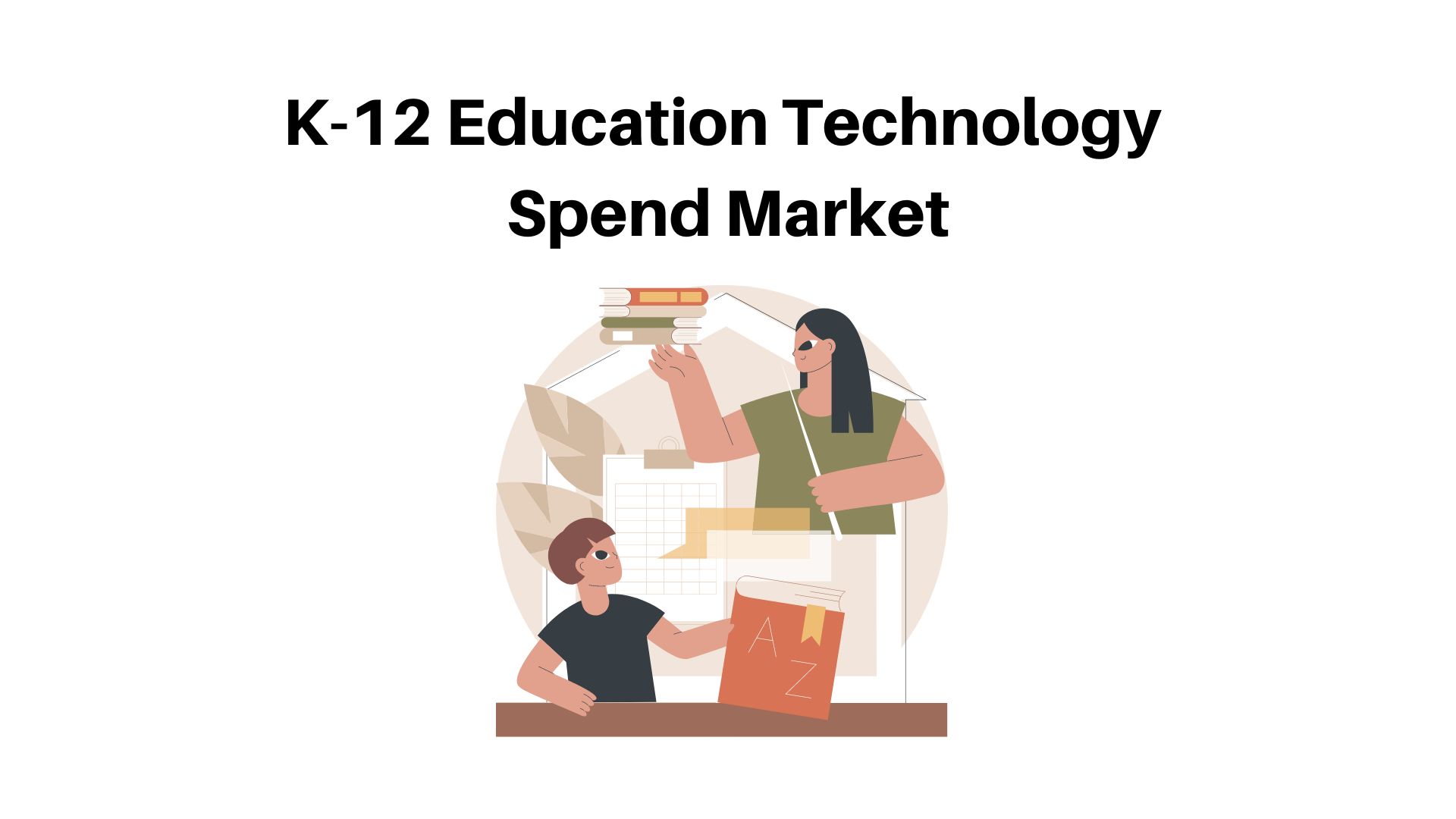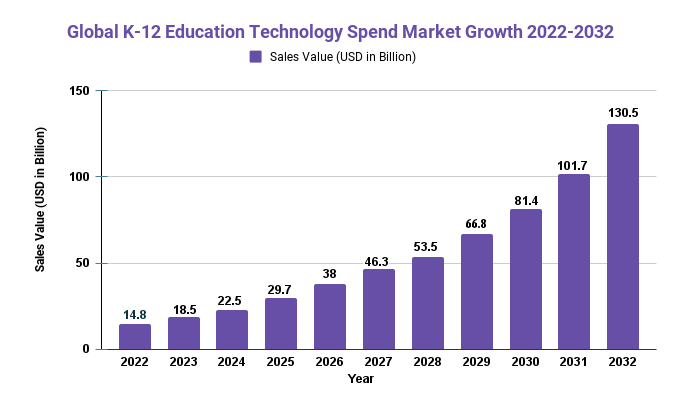K-12 Education Technology Spend Market to Reach USD 130.5 billion by 2032 | CAGR of 25%

Page Contents
Market Overview
Published Via 11Press: The K-12 Education Technology Spend Market size is expected to be worth around USD 130.5 Bn by 2032 from USD 14.8 Bn in 2022, growing at a CAGR of 25% during the forecast period from 2022 to 2032.
The K-12 education technology spending market is a rapidly growing industry driven by the increasing demand for digital learning solutions. The adoption of advanced technologies in classrooms has revolutionized the way students learn and teachers teach. In recent years, there has been a significant shift towards online learning platforms, digital textbooks, and interactive whiteboards in schools.
According to industry reports, the global K-12 education technology spending market is expected to reach $130.5 billion by 2032, with North America being the largest contributor to this growth. This exponential growth can be attributed to several factors such as rising student enrollment rates, increased government funding for education technology initiatives, and improved access to high-speed internet connections.
With advancements in artificial intelligence (AI) and machine learning (ML), educators are now able to personalize learning experiences for individual students based on their strengths and weaknesses.
Request For Sample Report Here: https://market.us/report/k-12-education-technology-spend-market/request-sample/

Key Takeaways
- In recent years, the K-12 education technology spending market has experienced rapid growth. Estimates place it at over 25% compound annual growth between 2022 and 2032.
- The COVID-19 pandemic has further spurred the adoption of education technology in K-12 schools, as remote and hybrid learning models become more commonplace.
- The K-12 education technology spending market offers a diverse selection of products and services, such as learning management systems, educational content, and software, hardware devices (such as laptops and tablets), professional development services, and support services.
- The market is fiercely competitive, with a multitude of vendors offering similar goods and services. Some of the major players include Chungdahm Learning, Dell, Educomp Solutions, Next Education, Samsung, TAL Education Group, Tata Class Edge, Adobe Systems, Blackboard, BenQ, Cengage Learning, D2L, Ellucian, IBM, Intel, Knewton, Mcmillan Learning, McGraw-Hill Education, Microsoft, Oracle.
- One of the greatest challenges facing K-12 schools is providing equitable access to technology and digital resources for all students, regardless of their socioeconomic background or geographic location. This should be a key consideration for vendors and policymakers as they work to shape the future of the education technology market.
Regional Analysis
- North America is currently the leading market for K-12 education technology spending, with the United States dominating in this region. Factors such as increased technology adoption in education, demand for personalized learning strategies, and digital classroom transformation are driving this market upwards.
- Europe is a significant market for K-12 education technology spending, with countries such as the United Kingdom, Germany, and France playing a significant role. The market in Europe is driven by factors such as increased use of digital content in classrooms, rising demand for e-learning solutions, and rising popularity of online tutoring services.
- The Asia-Pacific region is forecast to experience the fastest growth in K-12 education technology spending over the coming years due to factors such as increased adoption of technology in schools, the rise of online learning platforms, and an increasing need for mobile learning solutions. China and India are expected to be major contributors to this market within this region.
- Latin America is an emerging market for K-12 education technology spending, with countries such as Brazil, Mexico, and Argentina dominating the region. Factors driving this growth include increased adoption of technology in education, demand for personalized learning strategies, and the emergence of online educational platforms.
- Middle East and Africa The K-12 education technology spending market in the Middle East and Africa region are expected to experience steady growth over the coming years, driven by factors such as increasing technology use in schools, demand for e-learning solutions, and growing interest in online tutoring services. Countries like the United Arab Emirates and South Africa are anticipated to be major contributors to this regional market.
Drivers
- Adoption of Technology in Education, The increasing adoption of technology in education is a major driver of the K-12 education technology spending market. As schools and educators realize the potential of technology to enhance student learning outcomes and engagement, they are investing more in technology solutions.
- Personalized Learning, Another driver of the K-12 education technology spending market is the growing demand for personalized learning. Technology solutions such as learning management systems and adaptive learning platforms enable educators to provide personalized learning experiences that cater to the individual needs and learning styles of students.
- Rise of Digital Classrooms, The COVID-19 pandemic has accelerated the trend toward digital classrooms, as schools have had to adopt remote and hybrid learning models. This has led to increased investment in technology solutions such as videoconferencing software, online learning platforms, and collaboration tools.
- Demand for E-learning Solutions, The growing demand for e-learning solutions is another driver of the K-12 education technology spending market. E-learning solutions enable students to access educational content and resources anytime, anywhere, and at their own pace.
- Mobile Learning, The increasing use of mobile devices such as smartphones and tablets in education is driving investment in mobile learning solutions. Mobile learning solutions enable students to access educational content and resources on their mobile devices, making learning more convenient and accessible.
- Teacher Professional Development, The effective use of technology in education requires teachers to have the necessary skills and knowledge. As a result, investment in teacher professional development programs and support services is also driving the K-12 education technology spending market.
Browse the summary of the report and Complete Table of Contents (TOC): https://market.us/report/k-12-education-technology-spend-market/table-of-content/
Restraints
- Lack of Infrastructure, One of the major restraints of the K-12 education technology spending market is the lack of infrastructure in some regions. This includes issues such as limited access to high-speed internet, insufficient power supply, and inadequate technology infrastructure in schools.
- Budget Constraints, K-12 schools often have limited budgets, which can make it difficult to invest in expensive technology solutions. This is particularly true for schools in low-income areas, where budgets may be limited even further.
- Data Privacy and Security Concerns, The increasing use of technology in education has raised concerns about data privacy and security. Schools need to ensure that students' personal information is protected and that data is stored securely.
- Integration Challenges, Another restraint of the K-12 education technology spending market is the challenge of integrating technology solutions into existing educational systems and workflows. This requires careful planning and coordination, as well as training for teachers and staff.
- Technical Support and Maintenance, K-12 schools need to ensure that their technology solutions are functioning properly and are well-maintained. This requires investment in technical support and maintenance services, which can be costly and time-consuming.
- Equity and Access, Equitable access to technology and digital resources for all students, regardless of their socioeconomic background or geographic location, is a significant challenge for the K-12 education technology spending market. Schools need to ensure that all students have access to the technology solutions they need to succeed in their education.
Opportunities
- Cloud-based solutions present significant potential in the K-12 education technology spending market. They can offer schools cost-effective, scalable, and flexible ways to access technology solutions and services. Artificial Intelligence and Machine Learning, Utilizing artificial intelligence and machine learning in educational technology solutions offers significant potential to enhance learning outcomes and personalize student experiences. These technologies can identify learning gaps, suggest personalized paths for improvement, and offer real-time feedback to students.
- Gamification can be used effectively in educational technology solutions to boost student engagement and motivation. This presents educational technology companies with an exciting opportunity to create innovative, engaging solutions that help learners learn. Virtual and augmented reality in education technology solutions presents unique opportunities to create immersive learning experiences, helping students better comprehend complex ideas and concepts.
- Open Educational Resources, Utilizing open educational resources (OERs) presents a significant opportunity to reduce the cost of instructional materials and increase access to high-quality educational materials. Education technology companies can develop solutions that make it simpler for schools to locate and utilize OERs. Professional Development, With the growing use of technology in education, teachers need to possess the necessary skills and knowledge to efficiently use technology solutions in the classroom. This presents educational technology companies with an opportunity to develop professional development programs and support services that can help teachers hone their technology proficiency.
Challenges
- Digital Divide: The digital divide presents a major obstacle in K-12 education technology spending. Not all students have equal access to technology and high-speed internet, leading to disparities in learning opportunities and outcomes.
- Implementation Challenges: Implementing technology solutions in K-12 schools can be a complex and time-consuming task. This includes challenges such as integrating them into existing educational systems, providing training for teachers and staff, and ensuring that these tools are regularly maintained and supported.
- Funding K-12 schools often face limited budgets: making investing in costly technology solutions difficult. This poses challenges when trying to provide students with the tools and resources necessary for success at school.
- Data Privacy and Security: With the increasing use of technology in education, concerns have arisen regarding data privacy and security. Schools must ensure that students' personal information is safeguarded and stored safely.
- Technical Support and Maintenance: K-12 schools must guarantee their technology solutions are running optimally and regularly maintained. To do this, schools must invest in technical support and maintenance services which may be costly and time-consuming investments.
- Equity and Access: Ensuring equitable access to technology and digital resources for all students, regardless of socioeconomic background or geographic location, remains a significant challenge in the K-12 education technology spending market. Schools must ensure all pupils have access to the tools necessary for success in their educational journey.
Report Scope
| Report Attribute | Details |
| The market size value in 2022 | USD 14.8 Bn |
| Revenue forecast by 2032 | USD 130.5 Bn |
| Growth Rate | CAGR Of 25% |
| Regions Covered | North America, Europe, Asia Pacific, Latin America, and Middle East & Africa, and the Rest of the World |
| Historical Years | 2017-2022 |
| Base Year | 2022 |
| Estimated Year | 2023 |
| Short-Term Projection Year | 2028 |
| Long-Term Projected Year | 2032 |
Key Market Segments
Type
- Hardware
- Software
- Solution
- Support
Application
- Pre-primary School
- Primary School
- Middle School
- High School
Key Market Players
- Chungdahm Learning
- Dell
- Educomp Solutions
- Next Education
- Samsung
- TAL Education Group
- Tata Class Edge
- Adobe Systems
- Blackboard
- BenQ
- Cengage Learning
- D2L
- Ellucian
- IBM
- Intel
- Knewton
- Mcmillan Learning
- McGraw-Hill Education
- Microsoft
- Oracle
Frequently Asked Questions
What is the market study period?
The K-12 Education Technology Spend Market is studied from 2017 – 2032.
What is the growth rate for the K-12 Education Technology Spend Market?
The K-12 Education Technology Spend Market is growing at a CAGR of 25%
Who are the major players in the K-12 Education Technology Spend Market?
Chungdahm Learning, Dell, Educomp Solutions, Next Education, Samsung, TAL Education Group, Tata Class Edge, Adobe Systems, Blackboard, BenQ, Cengage Learning, D2L, Ellucian, IBM, Intel, Knewton, Mcmillan Learning, McGraw-Hill Education, Microsoft, Oracle
The team behind market.us, marketresearch.biz, market.biz and more. Our purpose is to keep our customers ahead of the game with regard to the markets. They may fluctuate up or down, but we will help you to stay ahead of the curve in these market fluctuations. Our consistent growth and ability to deliver in-depth analyses and market insight has engaged genuine market players. They have faith in us to offer the data and information they require to make balanced and decisive marketing decisions.



